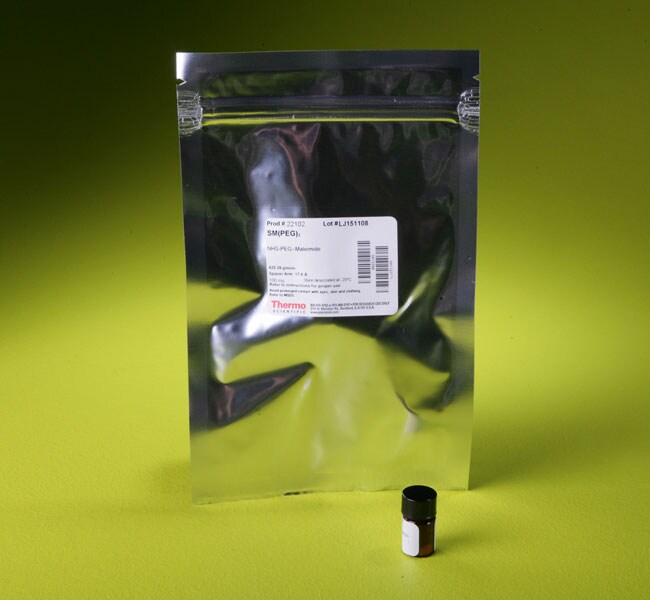
Thermo Scientific Pierce SM(PEG)n is a series of amine-to-sulfhydryl crosslinkers that differ in length from 17.6 to 95.2 angstroms as a result of polyethylene glycol spacer arms containing n equals 2 to 24 ethylene glycol units.
Features of SM(PEG)2:
• Reactive groups: NHS ester and maleimide
• Reactive toward: amino and sulfhydryl groups
• Irreversibly crosslink proteins or peptides by flexible PEG spacer arms
• Polyethylene glycol spacer arms help maintain conjugate solubility
• Pure compound with defined structure and molecular weight, ensuring reproducible protein-modification effects
• PEG spacer provides unique advantages, including increased stability, reduced tendency toward aggregation and reduced immunogenicity
• Ideal for performing controlled, two-step protein conjugations (see Sulfo-SMCC)
SM(PEG)n NHS- and maleimide-activated PEG compounds for crosslinking between primary amines (NH2) and sulfhydryl (SH) groups in proteins and other molecules. A complete set of compounds are offered, each having the same heterobifunctional structure (NHS-PEGn-Maleimide) but differing in the number of discrete ethylene glycol units ( n = 2, 4, 6, 8, 12 or 24). The N-hydroxysuccinimide ester (NHS) group reacts specifically and efficiently with lysine and N-terminal amino groups at pH 7-9 to form stable amide bonds. The maleimide group reacts with reduced sulfhydryls at pH 6.5-7.5 to form stable thioether bonds.
Alternative Names for SM(PEG)n:
• NHS-dPEG-Mal
• Mal-PEG NHS ester
• NHS-PEO-Maleimide
• Succinimidyl-dPEG-maleimide
• Succinimide-Maleimide PEG
Why use crosslinkers with polyethylene glycol (PEG) spacer arms?
PEG-containing reagents have been used to modify proteins to provide specific advantages. Protein PEGylation can improve the stability of the modified protein, protect it from proteolytic digestion, increase its half life in a biological application, mask it from causing an immunogenic response, decrease its antigenicity or potential toxicity, improve its solubility, diminish the potential for aggregation, and minimize interference for both in vitro and in vivo applications. Polyethylene glycol has these effects because it is nontoxic, nonimmunogenic, hydrophilic, water soluble and highly flexible.
Advantages of discrete-length polyethylene glycol compounds:
These reagents are specially synthesized, resulting in homogeneous compounds of defined molecular weight, characterized by discrete chain lengths, providing a greater ability to optimize and characterize surface protein modifications. Typical preparations of PEG compounds are a heterogeneous mixtures composed of a distribution of chain lengths with a specified average molecular weight or approximate number of PEG subunits.
Related Products
SM(PEG)4 (PEGylated SMCC crosslinker)
SM(PEG)6 (PEGylated, long-chain SMCC crosslinker)
SM(PEG)8 (PEGylated, long-chain SMCC crosslinker)
| Code | Description |
|---|---|
| 22102 | Catalog Number: 22102 |
| 22103 | Catalog Number: 22103 |

